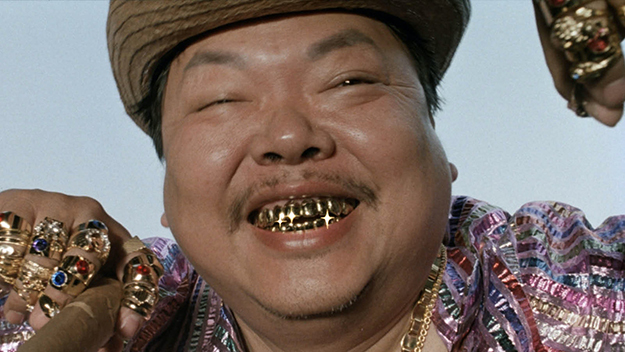This article appeared in the December 1, 2022 edition of The Film Comment Letter, our free weekly newsletter featuring original film criticism and writing. Sign up for the Letter here.

What’s Up Connection (Masashi Yamamoto, 1990)
The hop-skip nomadism of Masashi Yamamoto’s early narrative work can be said to be defined by three salient tendencies: the late-’70s jishu eiga, or “self-made films” movement, which countered the Japanese studio system with a rush of 8mm and 16mm vérités; home-seeking, an acute desire to build or find one’s place in the world; and political anarchism, with its passion for flagrant resistance. All three strands are plaited together in Yamamoto’s jishu contributions, Prelude to the Murder of a Prison Guard (1979), about a man magpieing objects in order to construct his own miniature city, and Carnival in the Night (1981), in which a fresh divorcée traipses around Tokyo’s punk underbelly, feverishly trying to jilt domesticity and rebuild herself.
Disinterested in Japanese cinema’s preoccupation with a cosseted middle class (as Yamamoto calls it, “salarymen going ballroom dancing”), the maverick filmmaker’s lens is instead absorbed with weirdos, grifters, and nonconformists, infusing his depictions of marginality with a ludic, anti-capitalist bent. When he pivoted to 35mm production in the 1980s, his ideological scope also expanded, but the tenor of his absurdist, go-for-broke jishu approach never changed. Two recently restored Yamamoto films from this later era, Robinson’s Garden (1987) and What’s Up Connection (1990), display his penchant for antiestablishment world-building through hophead Socratic dialogues and histrionic family scenes.
Robinson’s Garden follows Kumi (Kumiko Ohta), a loafer and drug dealer who drunkenly happens upon a derelict building, which she decides is her new home in an effort to further remove herself from the tumult of the city. She plants cabbage, bedecks the gray concrete with spray paint and bedsheets, and gets high on the roof with idling friends and strangers, exchanging philosophies and fighting words. Kumi’s “garden” becomes a haven for the apparent dregs of Tokyo: stoners, artists, Americans, unsupervised children. This micro-counterculture offers a small solace to these floaters, who pursue an anti-consumerist credo that Yamamoto indulges and interrogates through Kumi’s various setbacks.
Unlike those of Robinson’s Garden, the characters in What’s Up Connection do not forsake their possessions, instead folding themselves into their oppressive conditions. The film sees an impoverished family from a sequestered Hong Kong fishing village win multiple contests, which promise them solo getaways to Japan, Thailand, Bali, and Disney World. “I guess the gods are on our side,” says the family patriarch. Unbeknownst to these lucky travelers, while they’re abroad and alone, big-time Japanese developers are plotting to raze their home and erect multinational trade buildings in its place.
The family’s scattered picaresque becomes not only a satire of class relations, but also a lesson in the various ways in which capitalism exhausts and plunders the entire Asian continent. In this Yamamoto double bill, every character is swindling and being swindled, and anarchy is wrought through slapstick and fantasy.
Saffron Maeve is a Toronto-based writer.